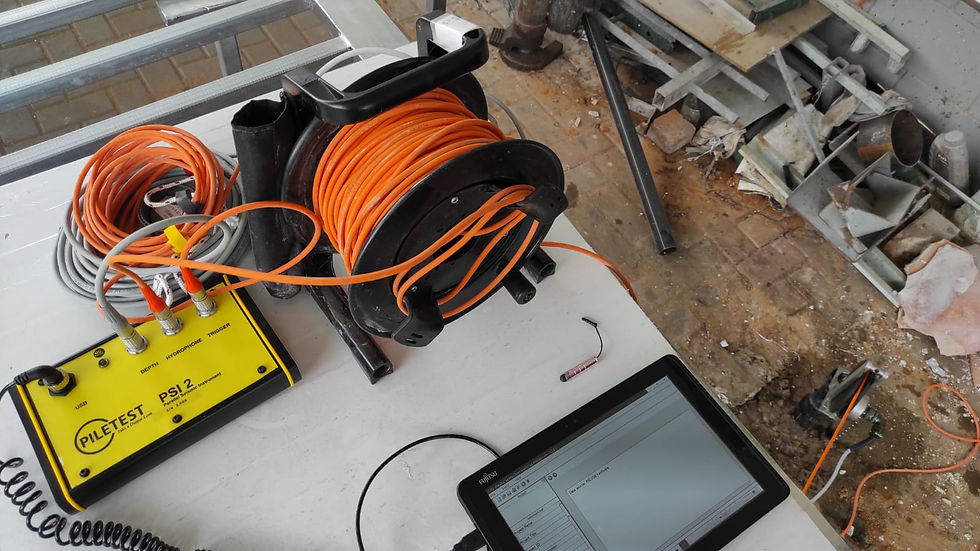








PSI
PSI uses the well-known Parallel Seismic method to establish the length of existing foundations (specifically for a pile or deep foundations) where the superstructure (i.e. existing building) precludes access to the pile heads.
It is sometimes the only pile integrity test that can be performed.
-
For making reuse of old piles
-
Easy to run test
-
Measures only the pile length under a structure
-
Standard compliant with
-
AFNOR NF P94-160-3
-
ASTM D8381-21
-
Application
The test requires the installation of a plastic access tube in parallel and as close as possible to the tested pile. The tube should be carried down to a depth exceeding the assumed pile length by a margin of 8-10 meters and filled with water.
In unsaturated soil the tube should be firmly grouted in the hole to achieve good coupling with the surrounding soil.
When sustainability requires old pile reuse, PSI offers a way to measure what pile length is real there

Reliable
-
Specially designed and tested for a hostile construction environment.
-
3-year warranty!
-
10 years free software
-
Rugged connectors, cables & sensors

Easy to Use
-
Easy to use: It is usually self-taught in less than a day. No additional expensive training is needed.
-
Interpretation assistance by Second Opinion Services (SOS) is included.

Top Perfromance
-
Highly sensitive acoustic sensors
-
Check any pile length up to 50m in less than 20 minutes
-
Test all types of piles
-
Weighs under 10Kg

Parallel Seismic test team in a construction site

PSI uses the parallel seismic method to measure the length of a pile under a structure

Parallel Seismic test team in a construction site in Thailand

Parallel Seismic test team in a construction site
PSI - Technical Specifications
Physical
Housing
Dimensions
Weight
Temperature range
Humidity
Waterproof
Sensor: Rugged metal case
Instrument: Rugged, Environment-proof
210W x 140L x 40H (instrument only)
6.0 kg (instrument with 50m cable)
0.8 kg (instrument only)
13.0kg (Typical shipping)
Operating : -25°C to 50°C
Storage : -40°C to 70°C
90% (non-condensing)
Sensor: Waterproof to 5ATM
Instrument: IP62, 90% condensation (light rain)
Power
External
USB cable, from computing device
Standards
ASTM D8381-21
AFNOR NF P94-160-3
Meets or exceeds
Technical
Hydrophone
Cables
Sample rate
Resolution
Depth accuracy
100Hz ~ 4kHz in stainless enclosure.
25 mm diameter
Heavy-duty polyurethane on reel.
50kHz (20μS resolution)
16bit A/D + 14 gain levels = 30bit dynamic range .
3mm resolution <0.1% error.
Performance
Pile length
Productivity
Memory Storage
1m-50m
10-15 min (depending on pile length) per pile
Unlimited
Output
Reporting
Language
Arrival time vs. depth
Pile tip depth
Wave speed in the pile
Multi-lingual report generation in MS Word format
Requirements
Computer (Minimum)
Windows Win7/Win10/Win11.
Screen resolution 1280 x 1024 min.
Other Customers Also Purchased
3D Tomography
3 Dimensional Tomography
While normal (1D) CSL can only show the depth of an anomaly, tomography can help in the visualization of the shape, size, and location of anomalies. It is an analysis and presentation method of captured CSL data, that projects the logged results into two dimensional (2D) plane or three dimensional (3D) body.

PET Bluetooth
Pile Integrity Tester
PET is used to test the integrity of deep pile foundations. PET Uses the pulse-echo method (PEM) for pile integrity testing (PIT). A pile test starts when the pile top is struck with a hammer, and the PET accelerometer records the reflected waves, which are displayed as a reflectogram.
Ordering Information
Downloads
Documents
ASTM D8381-21 Compliance
Software
Related Content
Leading Customers






















